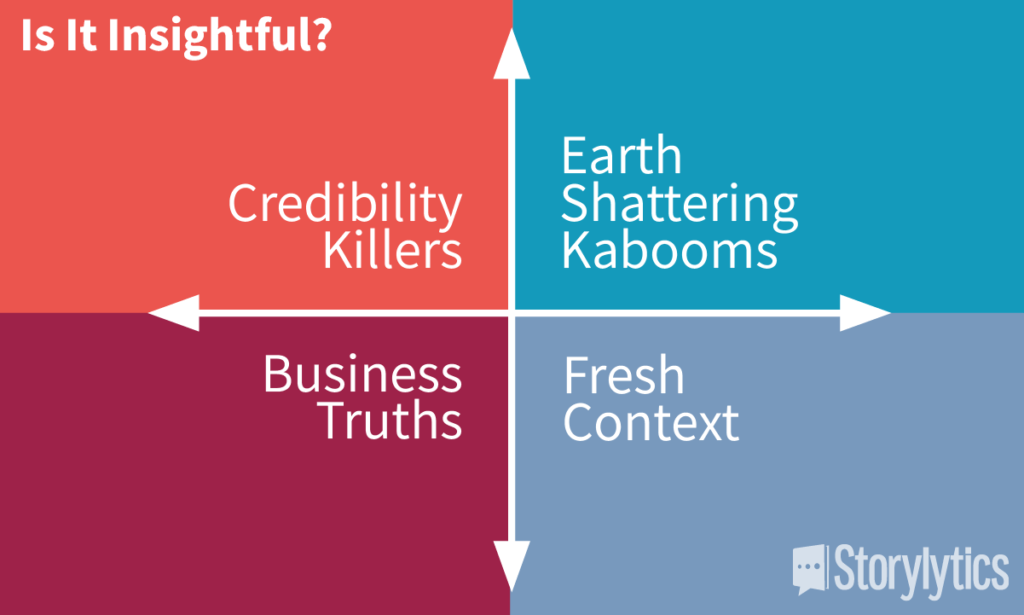I don’t think there’s any question that “insights” are the holy grail of analytics. Everyone wants them, many claim they can provide them, but few report actually getting anywhere with them. It’s the genesis of the well-worn phrase, “Data rich but insight poor.” So why—with all we have at our disposal today, from advanced analytic methodologies to visualization tools that claim insights at your fingertips—are we not consistently getting true, meaningful insights?
I think the answer starts with a quick hit of perspective: Just as beauty is in the eye of the beholder, insight is in the mind of the receiver. An insight is only an insight if the receiver believes it to be so.
With that in mind, let’s start with an audience-centric definition of an insight.
I believe insight fundamentally boils down to this: Something I did not already know that is relevant to the problem at hand. It combines both the what and the who of what an insight needs to deliver. What is it? New perspective. Who needs it? Decision makers. In the sharing of data, an insight is not about what the presenter believes is insightful; it is about what the receiver or decision maker feels is insightful.
What that really means is that the exchange of knowledge sits along two continuums—the perspective of the presenter, and the perspective of the audience. The bottom line is, audiences want and need to take action on what they learn. Therefore, a meaningful insight provides new knowledge that helps the audience act with confidence on the issue. (Everything to the right in the matrix below.) They range from challenging assumptions with relevant but niche knowledge, through to the rare, but truly disruptive, earth-shattering kabooms that redefine a space. Any audience change in perspective on an issue is when you know an insight is at work.

So, now that we have a better, audience-centric definition of what an insight truly is, the next question depends on who you are: If you’re the audience, how do I get the insights I need? If you’re the presenter, how do I provide true insights that will help to make a difference?
How can you get better insights? Provide more context around questions you ask of the presenter. If you ask for data, you’ll get data. If you start a conversation, you’ll get answers. And by conversation, I mean ask in the context of what’s truly going on—descriptive over prescriptive. What do you know, what do you not know, what are you wondering about. Your context gives incredible value to the problem at hand. You’ll be amazed at what will be uncovered, things you’ve never even thought of, if you can push yourself to ask questions from a curious, “how can we be better” position.
How can you provide better insights? Start the conversation. Don’t focus asking required data parameters, because—while they are important—this is not where the insights are going to be uncovered. An insight is new information that can be presented in the context of a business problem. And for that, we need to truly understand what our audience already knows and is thinking about to be able to understand what is going to be insightful for them.
A note about the left side of the matrix: You might be asking, “how do I know if I’m operating in the right quadrant?” (I see you looking uneasily at “Credibility Killers.”) Information on the left is still important, as it informs the analytic process and gives context to what is relevant to the audience. The how? Well, that’s a conversation for another day – I’ll address those questions and more in an “Insights – Part 2” in my next article.
Until then, remember—anyone can claim an insight, but a true insight, an insight that has the potential to make waves, is what you’re after. Slow down, apply context, look for a fresh perspective. The kabooms are waiting.
“The is the best storytelling course I have attended (and I have attended quite a few). I found it very valuable.”
If you’re wondering where you are on the matrix, or if you are trying to shift your position, let’s talk. Drop me an email at laura.warren@storylytics.ca
